Economic Growth of China and Major Challenges Faced
VerifiedAdded on 2023/01/11
|9
|2675
|100
AI Summary
This document discusses the economic growth of China and the three major challenges it faces today. It explores the environmental challenges, demographic challenges, and the impact of COVID-19 on China's economy. Additionally, it evaluates how globalization generates demand for resources and hinders development.
Contribute Materials
Your contribution can guide someone’s learning journey. Share your
documents today.

Questions
Secure Best Marks with AI Grader
Need help grading? Try our AI Grader for instant feedback on your assignments.
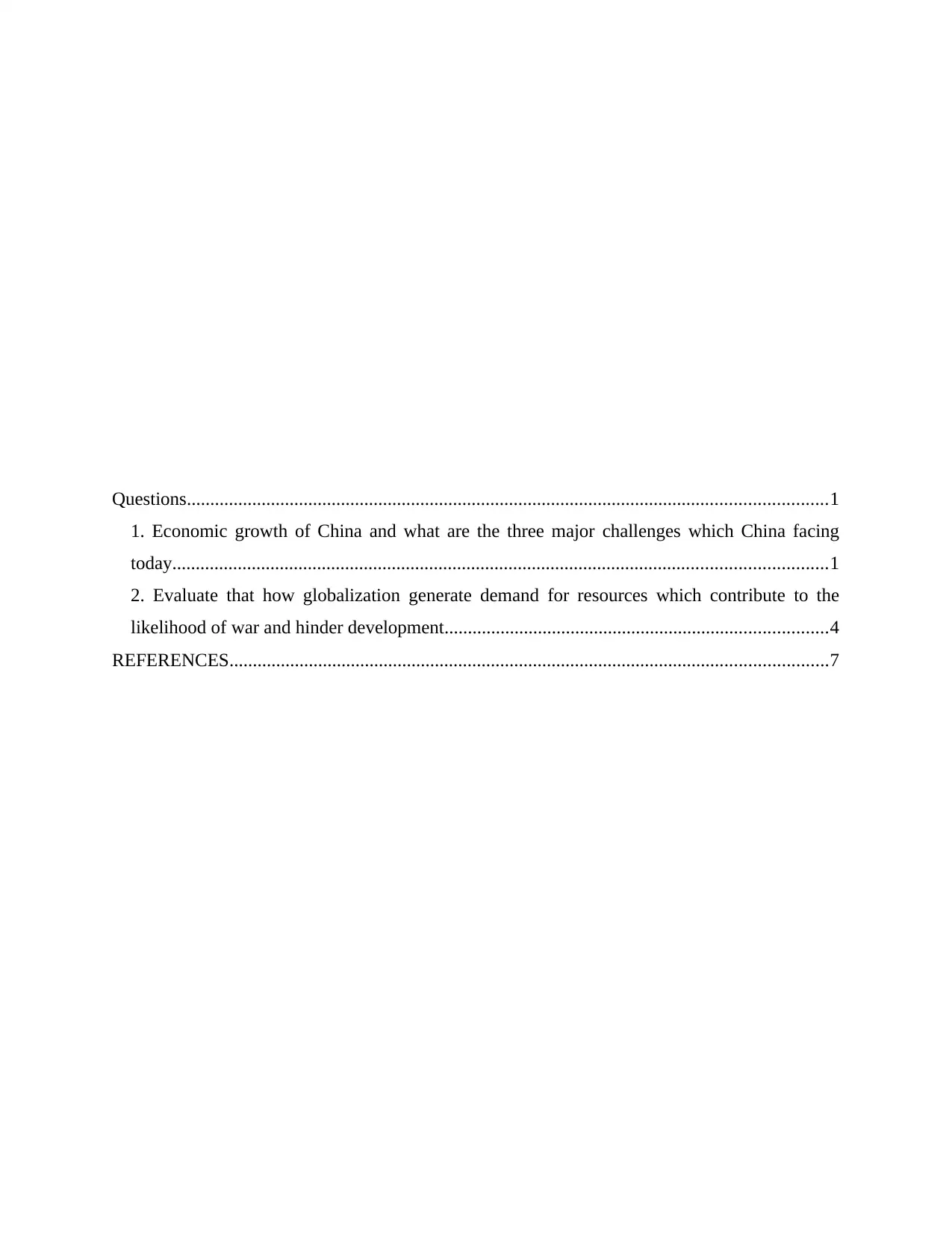
Questions.........................................................................................................................................1
1. Economic growth of China and what are the three major challenges which China facing
today............................................................................................................................................1
2. Evaluate that how globalization generate demand for resources which contribute to the
likelihood of war and hinder development..................................................................................4
REFERENCES................................................................................................................................7
1. Economic growth of China and what are the three major challenges which China facing
today............................................................................................................................................1
2. Evaluate that how globalization generate demand for resources which contribute to the
likelihood of war and hinder development..................................................................................4
REFERENCES................................................................................................................................7
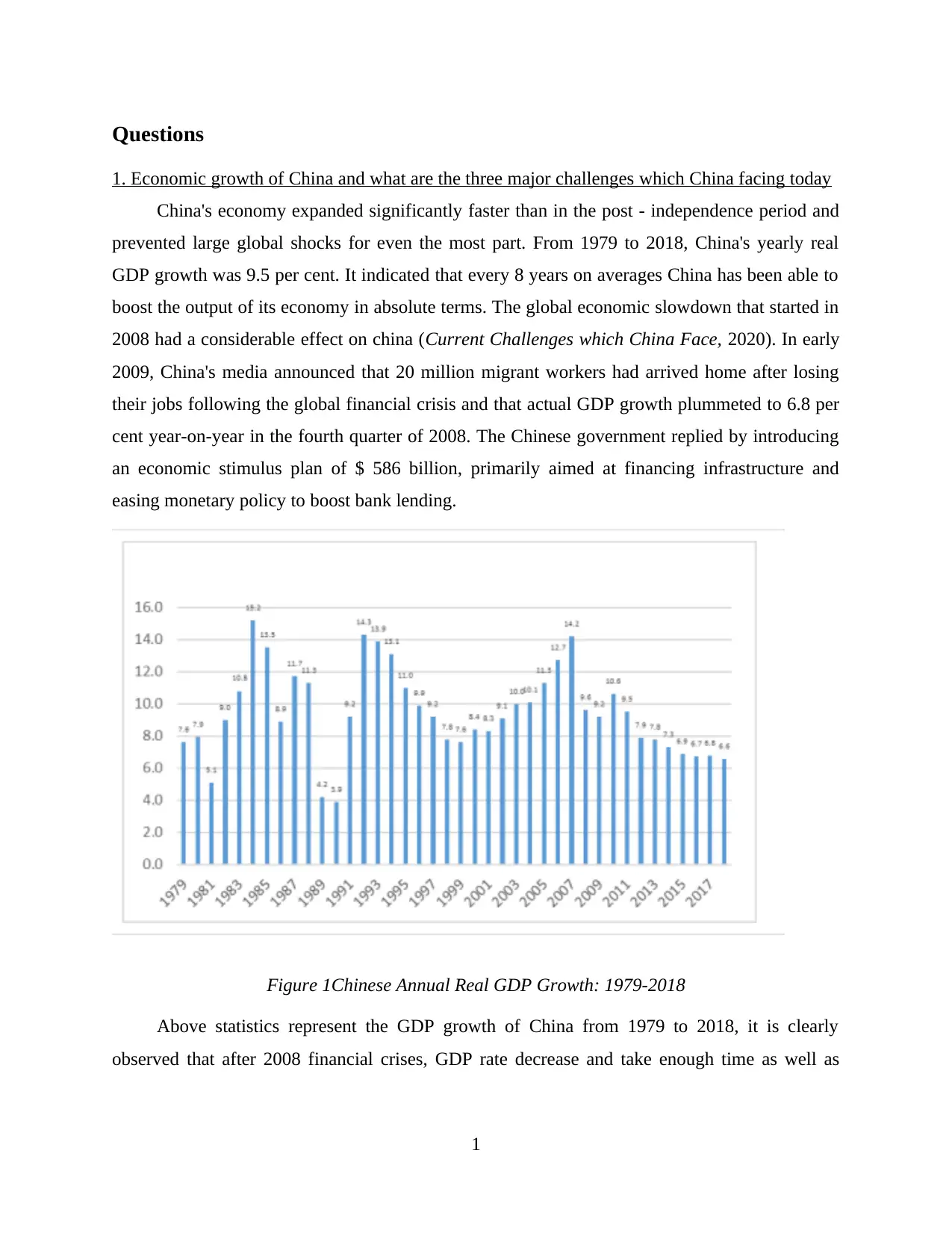
Questions
1. Economic growth of China and what are the three major challenges which China facing today
China's economy expanded significantly faster than in the post - independence period and
prevented large global shocks for even the most part. From 1979 to 2018, China's yearly real
GDP growth was 9.5 per cent. It indicated that every 8 years on averages China has been able to
boost the output of its economy in absolute terms. The global economic slowdown that started in
2008 had a considerable effect on china (Current Challenges which China Face, 2020). In early
2009, China's media announced that 20 million migrant workers had arrived home after losing
their jobs following the global financial crisis and that actual GDP growth plummeted to 6.8 per
cent year-on-year in the fourth quarter of 2008. The Chinese government replied by introducing
an economic stimulus plan of $ 586 billion, primarily aimed at financing infrastructure and
easing monetary policy to boost bank lending.
Figure 1Chinese Annual Real GDP Growth: 1979-2018
Above statistics represent the GDP growth of China from 1979 to 2018, it is clearly
observed that after 2008 financial crises, GDP rate decrease and take enough time as well as
1
1. Economic growth of China and what are the three major challenges which China facing today
China's economy expanded significantly faster than in the post - independence period and
prevented large global shocks for even the most part. From 1979 to 2018, China's yearly real
GDP growth was 9.5 per cent. It indicated that every 8 years on averages China has been able to
boost the output of its economy in absolute terms. The global economic slowdown that started in
2008 had a considerable effect on china (Current Challenges which China Face, 2020). In early
2009, China's media announced that 20 million migrant workers had arrived home after losing
their jobs following the global financial crisis and that actual GDP growth plummeted to 6.8 per
cent year-on-year in the fourth quarter of 2008. The Chinese government replied by introducing
an economic stimulus plan of $ 586 billion, primarily aimed at financing infrastructure and
easing monetary policy to boost bank lending.
Figure 1Chinese Annual Real GDP Growth: 1979-2018
Above statistics represent the GDP growth of China from 1979 to 2018, it is clearly
observed that after 2008 financial crises, GDP rate decrease and take enough time as well as
1
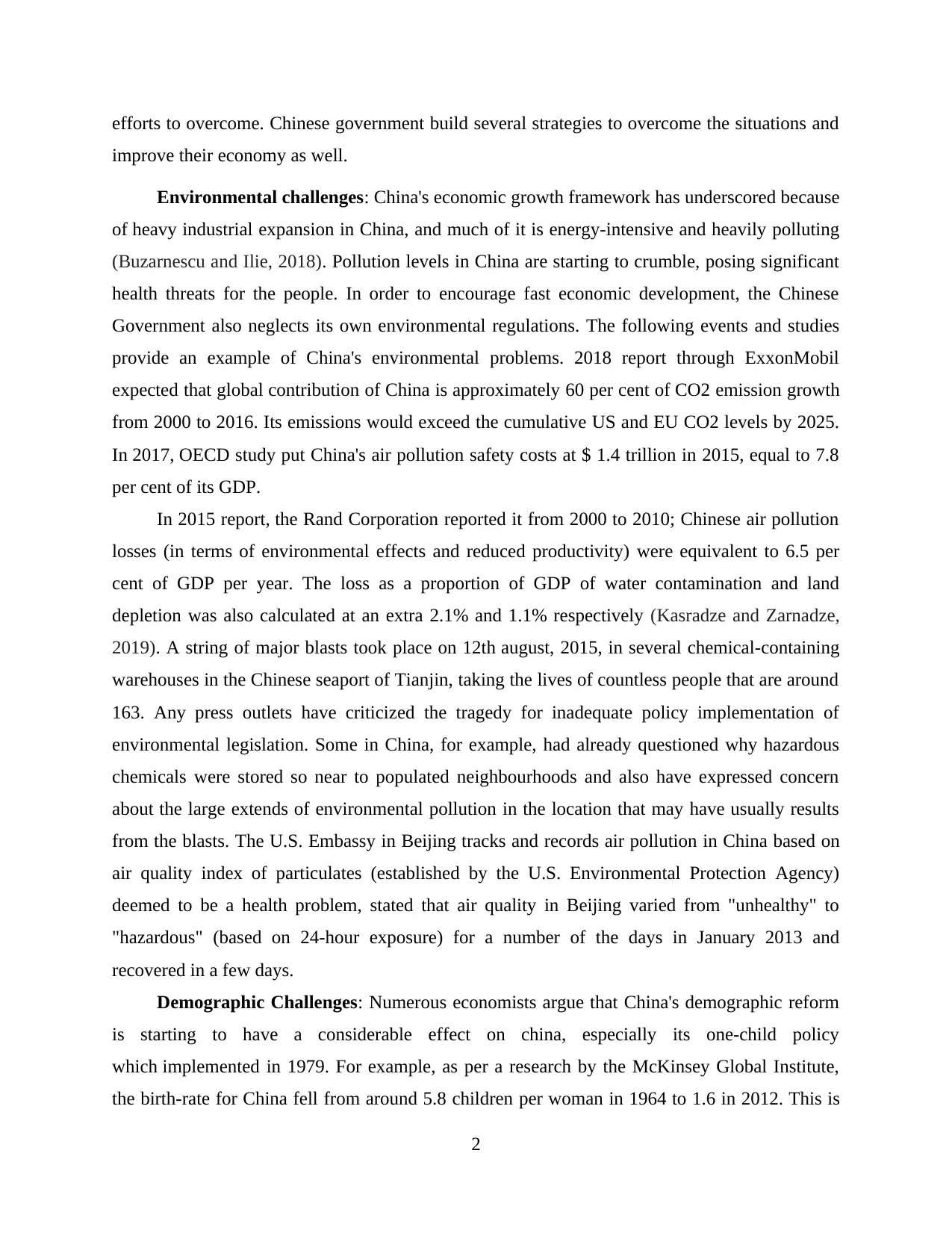
efforts to overcome. Chinese government build several strategies to overcome the situations and
improve their economy as well.
Environmental challenges: China's economic growth framework has underscored because
of heavy industrial expansion in China, and much of it is energy-intensive and heavily polluting
(Buzarnescu and Ilie, 2018). Pollution levels in China are starting to crumble, posing significant
health threats for the people. In order to encourage fast economic development, the Chinese
Government also neglects its own environmental regulations. The following events and studies
provide an example of China's environmental problems. 2018 report through ExxonMobil
expected that global contribution of China is approximately 60 per cent of CO2 emission growth
from 2000 to 2016. Its emissions would exceed the cumulative US and EU CO2 levels by 2025.
In 2017, OECD study put China's air pollution safety costs at $ 1.4 trillion in 2015, equal to 7.8
per cent of its GDP.
In 2015 report, the Rand Corporation reported it from 2000 to 2010; Chinese air pollution
losses (in terms of environmental effects and reduced productivity) were equivalent to 6.5 per
cent of GDP per year. The loss as a proportion of GDP of water contamination and land
depletion was also calculated at an extra 2.1% and 1.1% respectively (Kasradze and Zarnadze,
2019). A string of major blasts took place on 12th august, 2015, in several chemical-containing
warehouses in the Chinese seaport of Tianjin, taking the lives of countless people that are around
163. Any press outlets have criticized the tragedy for inadequate policy implementation of
environmental legislation. Some in China, for example, had already questioned why hazardous
chemicals were stored so near to populated neighbourhoods and also have expressed concern
about the large extends of environmental pollution in the location that may have usually results
from the blasts. The U.S. Embassy in Beijing tracks and records air pollution in China based on
air quality index of particulates (established by the U.S. Environmental Protection Agency)
deemed to be a health problem, stated that air quality in Beijing varied from "unhealthy" to
"hazardous" (based on 24-hour exposure) for a number of the days in January 2013 and
recovered in a few days.
Demographic Challenges: Numerous economists argue that China's demographic reform
is starting to have a considerable effect on china, especially its one-child policy
which implemented in 1979. For example, as per a research by the McKinsey Global Institute,
the birth-rate for China fell from around 5.8 children per woman in 1964 to 1.6 in 2012. This is
2
improve their economy as well.
Environmental challenges: China's economic growth framework has underscored because
of heavy industrial expansion in China, and much of it is energy-intensive and heavily polluting
(Buzarnescu and Ilie, 2018). Pollution levels in China are starting to crumble, posing significant
health threats for the people. In order to encourage fast economic development, the Chinese
Government also neglects its own environmental regulations. The following events and studies
provide an example of China's environmental problems. 2018 report through ExxonMobil
expected that global contribution of China is approximately 60 per cent of CO2 emission growth
from 2000 to 2016. Its emissions would exceed the cumulative US and EU CO2 levels by 2025.
In 2017, OECD study put China's air pollution safety costs at $ 1.4 trillion in 2015, equal to 7.8
per cent of its GDP.
In 2015 report, the Rand Corporation reported it from 2000 to 2010; Chinese air pollution
losses (in terms of environmental effects and reduced productivity) were equivalent to 6.5 per
cent of GDP per year. The loss as a proportion of GDP of water contamination and land
depletion was also calculated at an extra 2.1% and 1.1% respectively (Kasradze and Zarnadze,
2019). A string of major blasts took place on 12th august, 2015, in several chemical-containing
warehouses in the Chinese seaport of Tianjin, taking the lives of countless people that are around
163. Any press outlets have criticized the tragedy for inadequate policy implementation of
environmental legislation. Some in China, for example, had already questioned why hazardous
chemicals were stored so near to populated neighbourhoods and also have expressed concern
about the large extends of environmental pollution in the location that may have usually results
from the blasts. The U.S. Embassy in Beijing tracks and records air pollution in China based on
air quality index of particulates (established by the U.S. Environmental Protection Agency)
deemed to be a health problem, stated that air quality in Beijing varied from "unhealthy" to
"hazardous" (based on 24-hour exposure) for a number of the days in January 2013 and
recovered in a few days.
Demographic Challenges: Numerous economists argue that China's demographic reform
is starting to have a considerable effect on china, especially its one-child policy
which implemented in 1979. For example, as per a research by the McKinsey Global Institute,
the birth-rate for China fell from around 5.8 children per woman in 1964 to 1.6 in 2012. This is
2
Secure Best Marks with AI Grader
Need help grading? Try our AI Grader for instant feedback on your assignments.
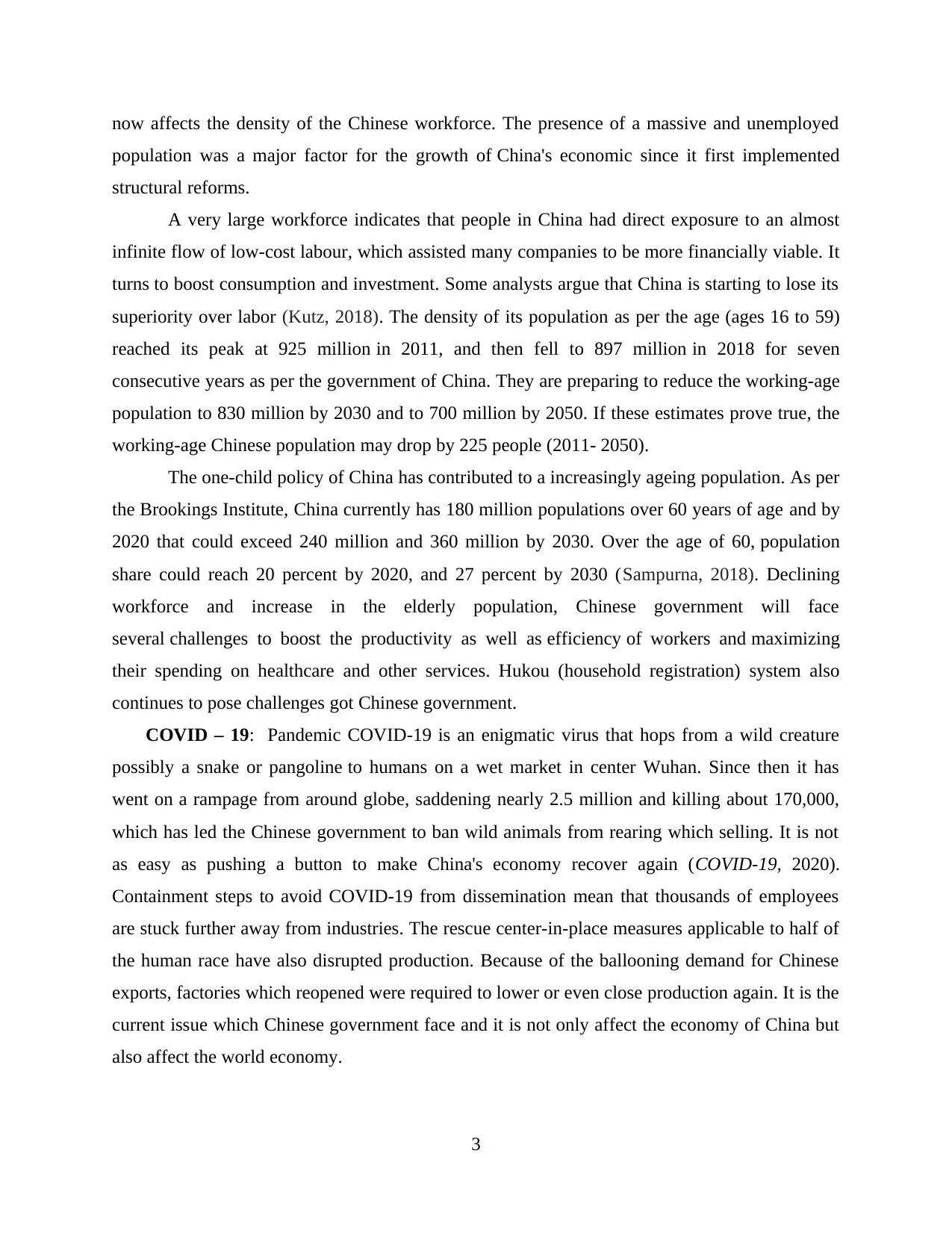
now affects the density of the Chinese workforce. The presence of a massive and unemployed
population was a major factor for the growth of China's economic since it first implemented
structural reforms.
A very large workforce indicates that people in China had direct exposure to an almost
infinite flow of low-cost labour, which assisted many companies to be more financially viable. It
turns to boost consumption and investment. Some analysts argue that China is starting to lose its
superiority over labor (Kutz, 2018). The density of its population as per the age (ages 16 to 59)
reached its peak at 925 million in 2011, and then fell to 897 million in 2018 for seven
consecutive years as per the government of China. They are preparing to reduce the working-age
population to 830 million by 2030 and to 700 million by 2050. If these estimates prove true, the
working-age Chinese population may drop by 225 people (2011- 2050).
The one-child policy of China has contributed to a increasingly ageing population. As per
the Brookings Institute, China currently has 180 million populations over 60 years of age and by
2020 that could exceed 240 million and 360 million by 2030. Over the age of 60, population
share could reach 20 percent by 2020, and 27 percent by 2030 (Sampurna, 2018). Declining
workforce and increase in the elderly population, Chinese government will face
several challenges to boost the productivity as well as efficiency of workers and maximizing
their spending on healthcare and other services. Hukou (household registration) system also
continues to pose challenges got Chinese government.
COVID – 19: Pandemic COVID-19 is an enigmatic virus that hops from a wild creature
possibly a snake or pangoline to humans on a wet market in center Wuhan. Since then it has
went on a rampage from around globe, saddening nearly 2.5 million and killing about 170,000,
which has led the Chinese government to ban wild animals from rearing which selling. It is not
as easy as pushing a button to make China's economy recover again (COVID-19, 2020).
Containment steps to avoid COVID-19 from dissemination mean that thousands of employees
are stuck further away from industries. The rescue center-in-place measures applicable to half of
the human race have also disrupted production. Because of the ballooning demand for Chinese
exports, factories which reopened were required to lower or even close production again. It is the
current issue which Chinese government face and it is not only affect the economy of China but
also affect the world economy.
3
population was a major factor for the growth of China's economic since it first implemented
structural reforms.
A very large workforce indicates that people in China had direct exposure to an almost
infinite flow of low-cost labour, which assisted many companies to be more financially viable. It
turns to boost consumption and investment. Some analysts argue that China is starting to lose its
superiority over labor (Kutz, 2018). The density of its population as per the age (ages 16 to 59)
reached its peak at 925 million in 2011, and then fell to 897 million in 2018 for seven
consecutive years as per the government of China. They are preparing to reduce the working-age
population to 830 million by 2030 and to 700 million by 2050. If these estimates prove true, the
working-age Chinese population may drop by 225 people (2011- 2050).
The one-child policy of China has contributed to a increasingly ageing population. As per
the Brookings Institute, China currently has 180 million populations over 60 years of age and by
2020 that could exceed 240 million and 360 million by 2030. Over the age of 60, population
share could reach 20 percent by 2020, and 27 percent by 2030 (Sampurna, 2018). Declining
workforce and increase in the elderly population, Chinese government will face
several challenges to boost the productivity as well as efficiency of workers and maximizing
their spending on healthcare and other services. Hukou (household registration) system also
continues to pose challenges got Chinese government.
COVID – 19: Pandemic COVID-19 is an enigmatic virus that hops from a wild creature
possibly a snake or pangoline to humans on a wet market in center Wuhan. Since then it has
went on a rampage from around globe, saddening nearly 2.5 million and killing about 170,000,
which has led the Chinese government to ban wild animals from rearing which selling. It is not
as easy as pushing a button to make China's economy recover again (COVID-19, 2020).
Containment steps to avoid COVID-19 from dissemination mean that thousands of employees
are stuck further away from industries. The rescue center-in-place measures applicable to half of
the human race have also disrupted production. Because of the ballooning demand for Chinese
exports, factories which reopened were required to lower or even close production again. It is the
current issue which Chinese government face and it is not only affect the economy of China but
also affect the world economy.
3
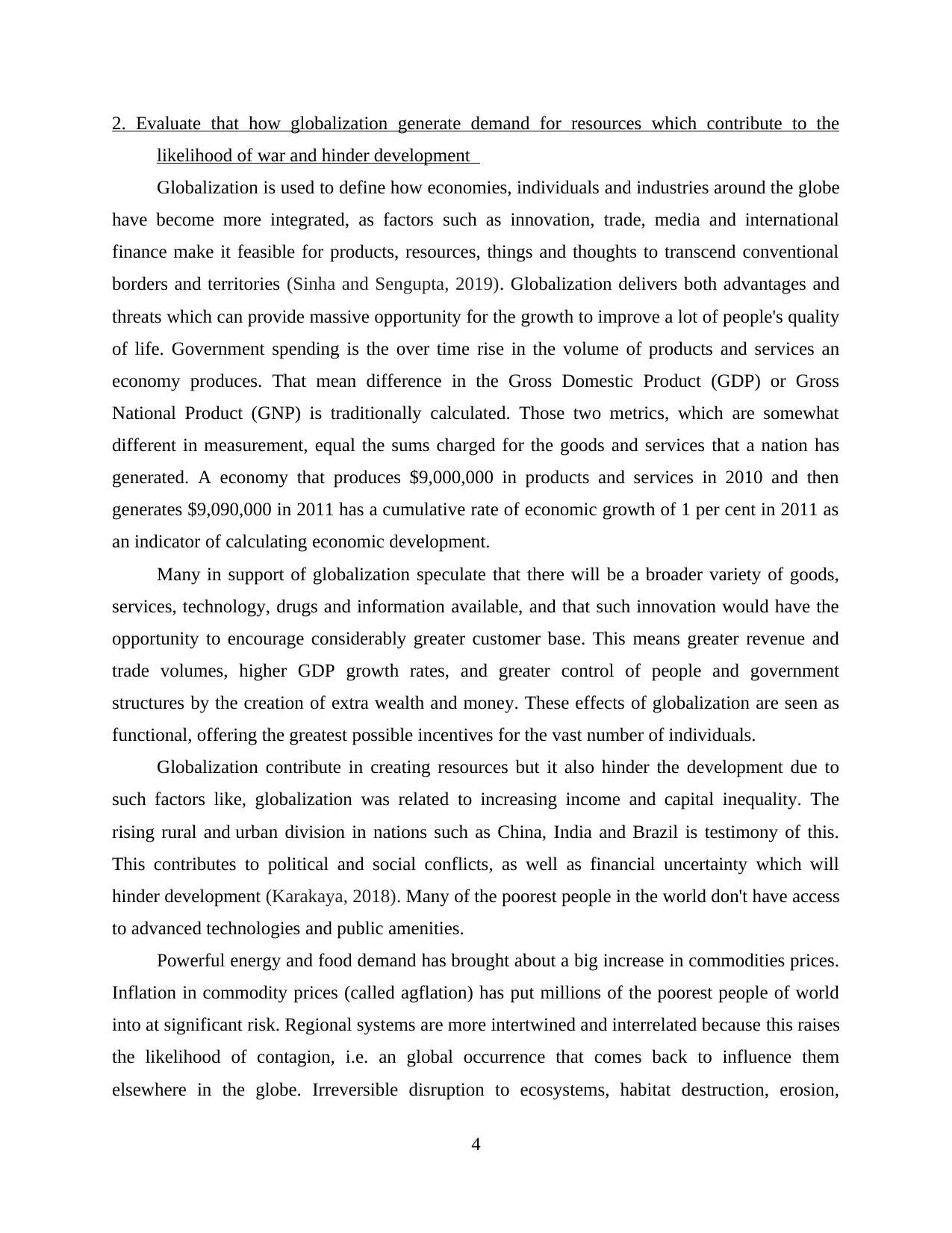
2. Evaluate that how globalization generate demand for resources which contribute to the
likelihood of war and hinder development
Globalization is used to define how economies, individuals and industries around the globe
have become more integrated, as factors such as innovation, trade, media and international
finance make it feasible for products, resources, things and thoughts to transcend conventional
borders and territories (Sinha and Sengupta, 2019). Globalization delivers both advantages and
threats which can provide massive opportunity for the growth to improve a lot of people's quality
of life. Government spending is the over time rise in the volume of products and services an
economy produces. That mean difference in the Gross Domestic Product (GDP) or Gross
National Product (GNP) is traditionally calculated. Those two metrics, which are somewhat
different in measurement, equal the sums charged for the goods and services that a nation has
generated. A economy that produces $9,000,000 in products and services in 2010 and then
generates $9,090,000 in 2011 has a cumulative rate of economic growth of 1 per cent in 2011 as
an indicator of calculating economic development.
Many in support of globalization speculate that there will be a broader variety of goods,
services, technology, drugs and information available, and that such innovation would have the
opportunity to encourage considerably greater customer base. This means greater revenue and
trade volumes, higher GDP growth rates, and greater control of people and government
structures by the creation of extra wealth and money. These effects of globalization are seen as
functional, offering the greatest possible incentives for the vast number of individuals.
Globalization contribute in creating resources but it also hinder the development due to
such factors like, globalization was related to increasing income and capital inequality. The
rising rural and urban division in nations such as China, India and Brazil is testimony of this.
This contributes to political and social conflicts, as well as financial uncertainty which will
hinder development (Karakaya, 2018). Many of the poorest people in the world don't have access
to advanced technologies and public amenities.
Powerful energy and food demand has brought about a big increase in commodities prices.
Inflation in commodity prices (called agflation) has put millions of the poorest people of world
into at significant risk. Regional systems are more intertwined and interrelated because this raises
the likelihood of contagion, i.e. an global occurrence that comes back to influence them
elsewhere in the globe. Irreversible disruption to ecosystems, habitat destruction, erosion,
4
likelihood of war and hinder development
Globalization is used to define how economies, individuals and industries around the globe
have become more integrated, as factors such as innovation, trade, media and international
finance make it feasible for products, resources, things and thoughts to transcend conventional
borders and territories (Sinha and Sengupta, 2019). Globalization delivers both advantages and
threats which can provide massive opportunity for the growth to improve a lot of people's quality
of life. Government spending is the over time rise in the volume of products and services an
economy produces. That mean difference in the Gross Domestic Product (GDP) or Gross
National Product (GNP) is traditionally calculated. Those two metrics, which are somewhat
different in measurement, equal the sums charged for the goods and services that a nation has
generated. A economy that produces $9,000,000 in products and services in 2010 and then
generates $9,090,000 in 2011 has a cumulative rate of economic growth of 1 per cent in 2011 as
an indicator of calculating economic development.
Many in support of globalization speculate that there will be a broader variety of goods,
services, technology, drugs and information available, and that such innovation would have the
opportunity to encourage considerably greater customer base. This means greater revenue and
trade volumes, higher GDP growth rates, and greater control of people and government
structures by the creation of extra wealth and money. These effects of globalization are seen as
functional, offering the greatest possible incentives for the vast number of individuals.
Globalization contribute in creating resources but it also hinder the development due to
such factors like, globalization was related to increasing income and capital inequality. The
rising rural and urban division in nations such as China, India and Brazil is testimony of this.
This contributes to political and social conflicts, as well as financial uncertainty which will
hinder development (Karakaya, 2018). Many of the poorest people in the world don't have access
to advanced technologies and public amenities.
Powerful energy and food demand has brought about a big increase in commodities prices.
Inflation in commodity prices (called agflation) has put millions of the poorest people of world
into at significant risk. Regional systems are more intertwined and interrelated because this raises
the likelihood of contagion, i.e. an global occurrence that comes back to influence them
elsewhere in the globe. Irreversible disruption to ecosystems, habitat destruction, erosion,
4
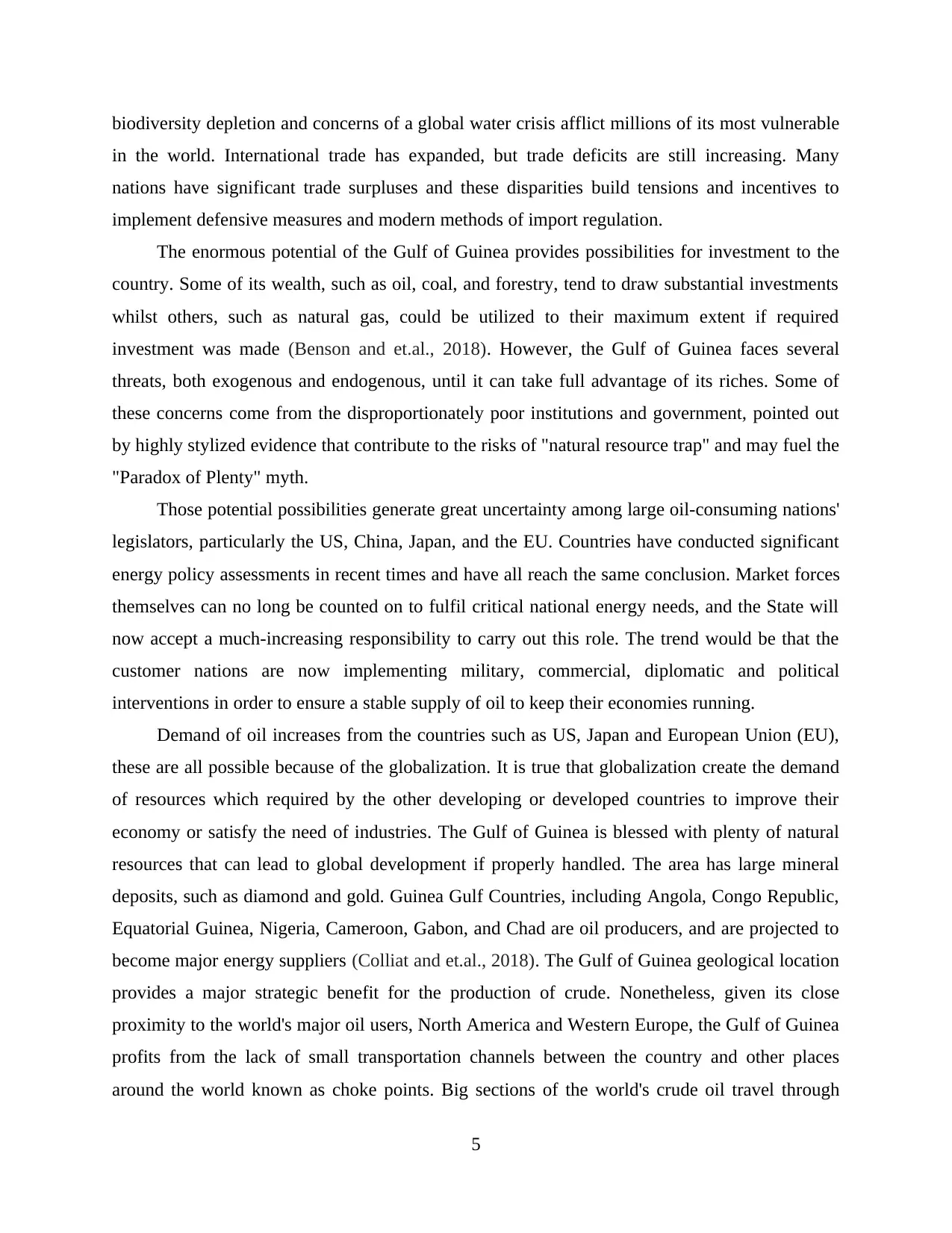
biodiversity depletion and concerns of a global water crisis afflict millions of its most vulnerable
in the world. International trade has expanded, but trade deficits are still increasing. Many
nations have significant trade surpluses and these disparities build tensions and incentives to
implement defensive measures and modern methods of import regulation.
The enormous potential of the Gulf of Guinea provides possibilities for investment to the
country. Some of its wealth, such as oil, coal, and forestry, tend to draw substantial investments
whilst others, such as natural gas, could be utilized to their maximum extent if required
investment was made (Benson and et.al., 2018). However, the Gulf of Guinea faces several
threats, both exogenous and endogenous, until it can take full advantage of its riches. Some of
these concerns come from the disproportionately poor institutions and government, pointed out
by highly stylized evidence that contribute to the risks of "natural resource trap" and may fuel the
"Paradox of Plenty" myth.
Those potential possibilities generate great uncertainty among large oil-consuming nations'
legislators, particularly the US, China, Japan, and the EU. Countries have conducted significant
energy policy assessments in recent times and have all reach the same conclusion. Market forces
themselves can no long be counted on to fulfil critical national energy needs, and the State will
now accept a much-increasing responsibility to carry out this role. The trend would be that the
customer nations are now implementing military, commercial, diplomatic and political
interventions in order to ensure a stable supply of oil to keep their economies running.
Demand of oil increases from the countries such as US, Japan and European Union (EU),
these are all possible because of the globalization. It is true that globalization create the demand
of resources which required by the other developing or developed countries to improve their
economy or satisfy the need of industries. The Gulf of Guinea is blessed with plenty of natural
resources that can lead to global development if properly handled. The area has large mineral
deposits, such as diamond and gold. Guinea Gulf Countries, including Angola, Congo Republic,
Equatorial Guinea, Nigeria, Cameroon, Gabon, and Chad are oil producers, and are projected to
become major energy suppliers (Colliat and et.al., 2018). The Gulf of Guinea geological location
provides a major strategic benefit for the production of crude. Nonetheless, given its close
proximity to the world's major oil users, North America and Western Europe, the Gulf of Guinea
profits from the lack of small transportation channels between the country and other places
around the world known as choke points. Big sections of the world's crude oil travel through
5
in the world. International trade has expanded, but trade deficits are still increasing. Many
nations have significant trade surpluses and these disparities build tensions and incentives to
implement defensive measures and modern methods of import regulation.
The enormous potential of the Gulf of Guinea provides possibilities for investment to the
country. Some of its wealth, such as oil, coal, and forestry, tend to draw substantial investments
whilst others, such as natural gas, could be utilized to their maximum extent if required
investment was made (Benson and et.al., 2018). However, the Gulf of Guinea faces several
threats, both exogenous and endogenous, until it can take full advantage of its riches. Some of
these concerns come from the disproportionately poor institutions and government, pointed out
by highly stylized evidence that contribute to the risks of "natural resource trap" and may fuel the
"Paradox of Plenty" myth.
Those potential possibilities generate great uncertainty among large oil-consuming nations'
legislators, particularly the US, China, Japan, and the EU. Countries have conducted significant
energy policy assessments in recent times and have all reach the same conclusion. Market forces
themselves can no long be counted on to fulfil critical national energy needs, and the State will
now accept a much-increasing responsibility to carry out this role. The trend would be that the
customer nations are now implementing military, commercial, diplomatic and political
interventions in order to ensure a stable supply of oil to keep their economies running.
Demand of oil increases from the countries such as US, Japan and European Union (EU),
these are all possible because of the globalization. It is true that globalization create the demand
of resources which required by the other developing or developed countries to improve their
economy or satisfy the need of industries. The Gulf of Guinea is blessed with plenty of natural
resources that can lead to global development if properly handled. The area has large mineral
deposits, such as diamond and gold. Guinea Gulf Countries, including Angola, Congo Republic,
Equatorial Guinea, Nigeria, Cameroon, Gabon, and Chad are oil producers, and are projected to
become major energy suppliers (Colliat and et.al., 2018). The Gulf of Guinea geological location
provides a major strategic benefit for the production of crude. Nonetheless, given its close
proximity to the world's major oil users, North America and Western Europe, the Gulf of Guinea
profits from the lack of small transportation channels between the country and other places
around the world known as choke points. Big sections of the world's crude oil travel through
5
Paraphrase This Document
Need a fresh take? Get an instant paraphrase of this document with our AI Paraphraser
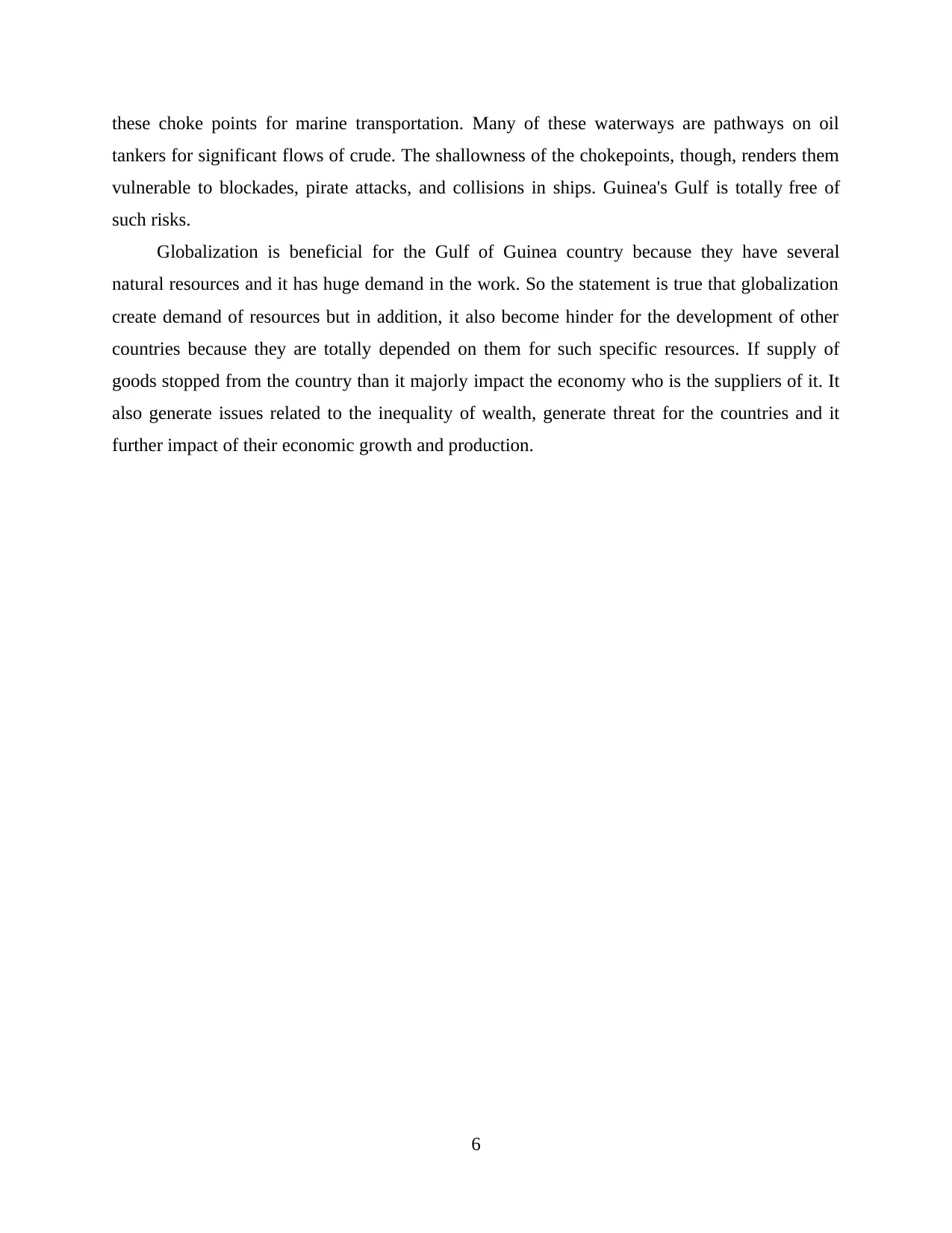
these choke points for marine transportation. Many of these waterways are pathways on oil
tankers for significant flows of crude. The shallowness of the chokepoints, though, renders them
vulnerable to blockades, pirate attacks, and collisions in ships. Guinea's Gulf is totally free of
such risks.
Globalization is beneficial for the Gulf of Guinea country because they have several
natural resources and it has huge demand in the work. So the statement is true that globalization
create demand of resources but in addition, it also become hinder for the development of other
countries because they are totally depended on them for such specific resources. If supply of
goods stopped from the country than it majorly impact the economy who is the suppliers of it. It
also generate issues related to the inequality of wealth, generate threat for the countries and it
further impact of their economic growth and production.
6
tankers for significant flows of crude. The shallowness of the chokepoints, though, renders them
vulnerable to blockades, pirate attacks, and collisions in ships. Guinea's Gulf is totally free of
such risks.
Globalization is beneficial for the Gulf of Guinea country because they have several
natural resources and it has huge demand in the work. So the statement is true that globalization
create demand of resources but in addition, it also become hinder for the development of other
countries because they are totally depended on them for such specific resources. If supply of
goods stopped from the country than it majorly impact the economy who is the suppliers of it. It
also generate issues related to the inequality of wealth, generate threat for the countries and it
further impact of their economic growth and production.
6

REFERENCES
Books & Journals
Benson, N. U. and et.al., 2018. New ecological risk indices for evaluating heavy metals
contamination in aquatic sediment: A case study of the Gulf of Guinea. Regional Studies
in Marine Science. 18. pp.44-56.
Buzarnescu, S. and Ilie, L. G., 2018. Socialist Market Economy-China in the Face of History:
Ideological Stereotypes, Praxeological Cliches, Historical Inertia. Rev. Universitara
Sociologie, p.8.
Colliat, J.L. and et.al., 2018. April. Formation and development of seabed trenching from subsea
inspection data of deepwater Gulf of Guinea moorings. In Offshore Technology
Conference. Offshore Technology Conference.
Karakaya, S., 2018. Globalization and contentious politics: A comparative analysis of nonviolent
and violent campaigns. Conflict management and peace science. 35(4). pp.315-335.
Kasradze, T. and Zarnadze, N., 2019, January. Challenges of Economic of Georgia: Good and
Bad Economic Growth. In 17th International Conference on Social Sciences Murcia, 8-9
March 2019 (p. 157).
Kutz, F. M., 2018. Motivation and disadvantages of entering Chinese startup clusters-Based on
the example of the German Mittelstand (Doctoral dissertation).
Sampurna, R. H., 2018. IS CHINA A THREAT TO INDONESIA: A DISCOURSE ANALYSIS
OF MAJOR INDONESIAN NEWSPAPERS’COVERAGE ON THE CHINA
ISSUES. JISPO: Jurnal Ilmu Sosial dan Ilmu Politik. 8(1). pp.209-231.
Sinha, A. and Sengupta, T., 2019. Impact of natural resource rents on human development: What
is the role of globalization in Asia Pacific countries?. Resources Policy. 63. p.101413.
Online
COVID-19. 2020. [Online]. Available Through:
<https://time.com/5824599/china-coronavirus-covid19-economy/>
Current Challenges which China Face. 2020. [Online]. Available Through:
< https://www.everycrsreport.com/reports/RL33534.html#_Ref366159479>
7
Books & Journals
Benson, N. U. and et.al., 2018. New ecological risk indices for evaluating heavy metals
contamination in aquatic sediment: A case study of the Gulf of Guinea. Regional Studies
in Marine Science. 18. pp.44-56.
Buzarnescu, S. and Ilie, L. G., 2018. Socialist Market Economy-China in the Face of History:
Ideological Stereotypes, Praxeological Cliches, Historical Inertia. Rev. Universitara
Sociologie, p.8.
Colliat, J.L. and et.al., 2018. April. Formation and development of seabed trenching from subsea
inspection data of deepwater Gulf of Guinea moorings. In Offshore Technology
Conference. Offshore Technology Conference.
Karakaya, S., 2018. Globalization and contentious politics: A comparative analysis of nonviolent
and violent campaigns. Conflict management and peace science. 35(4). pp.315-335.
Kasradze, T. and Zarnadze, N., 2019, January. Challenges of Economic of Georgia: Good and
Bad Economic Growth. In 17th International Conference on Social Sciences Murcia, 8-9
March 2019 (p. 157).
Kutz, F. M., 2018. Motivation and disadvantages of entering Chinese startup clusters-Based on
the example of the German Mittelstand (Doctoral dissertation).
Sampurna, R. H., 2018. IS CHINA A THREAT TO INDONESIA: A DISCOURSE ANALYSIS
OF MAJOR INDONESIAN NEWSPAPERS’COVERAGE ON THE CHINA
ISSUES. JISPO: Jurnal Ilmu Sosial dan Ilmu Politik. 8(1). pp.209-231.
Sinha, A. and Sengupta, T., 2019. Impact of natural resource rents on human development: What
is the role of globalization in Asia Pacific countries?. Resources Policy. 63. p.101413.
Online
COVID-19. 2020. [Online]. Available Through:
<https://time.com/5824599/china-coronavirus-covid19-economy/>
Current Challenges which China Face. 2020. [Online]. Available Through:
< https://www.everycrsreport.com/reports/RL33534.html#_Ref366159479>
7
1 out of 9
Related Documents
Your All-in-One AI-Powered Toolkit for Academic Success.
+13062052269
info@desklib.com
Available 24*7 on WhatsApp / Email
![[object Object]](/_next/static/media/star-bottom.7253800d.svg)
Unlock your academic potential
© 2024 | Zucol Services PVT LTD | All rights reserved.




